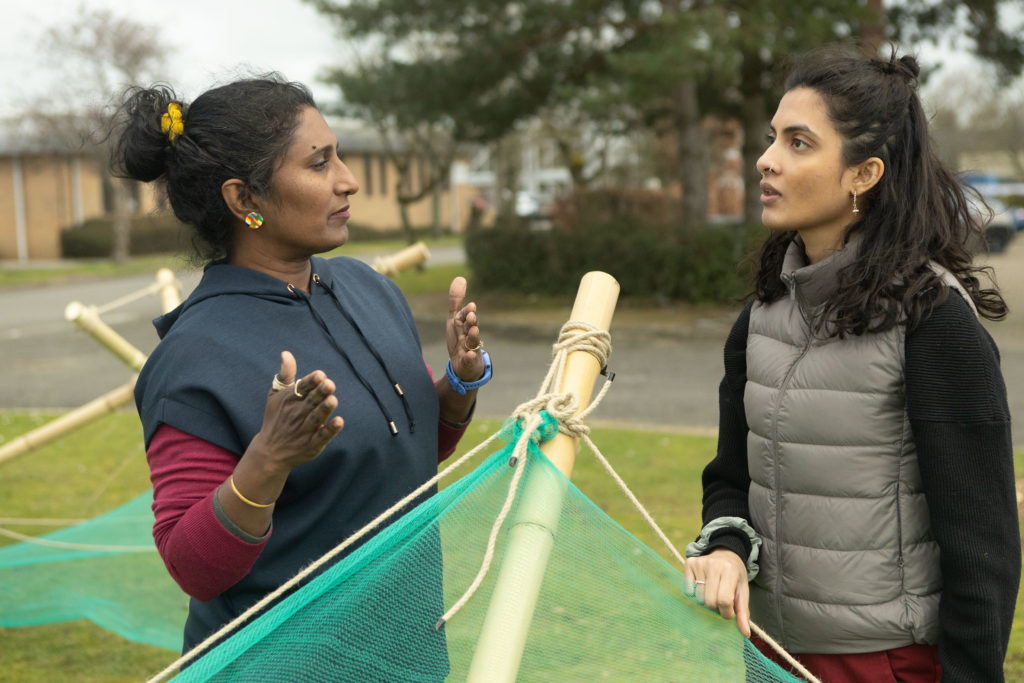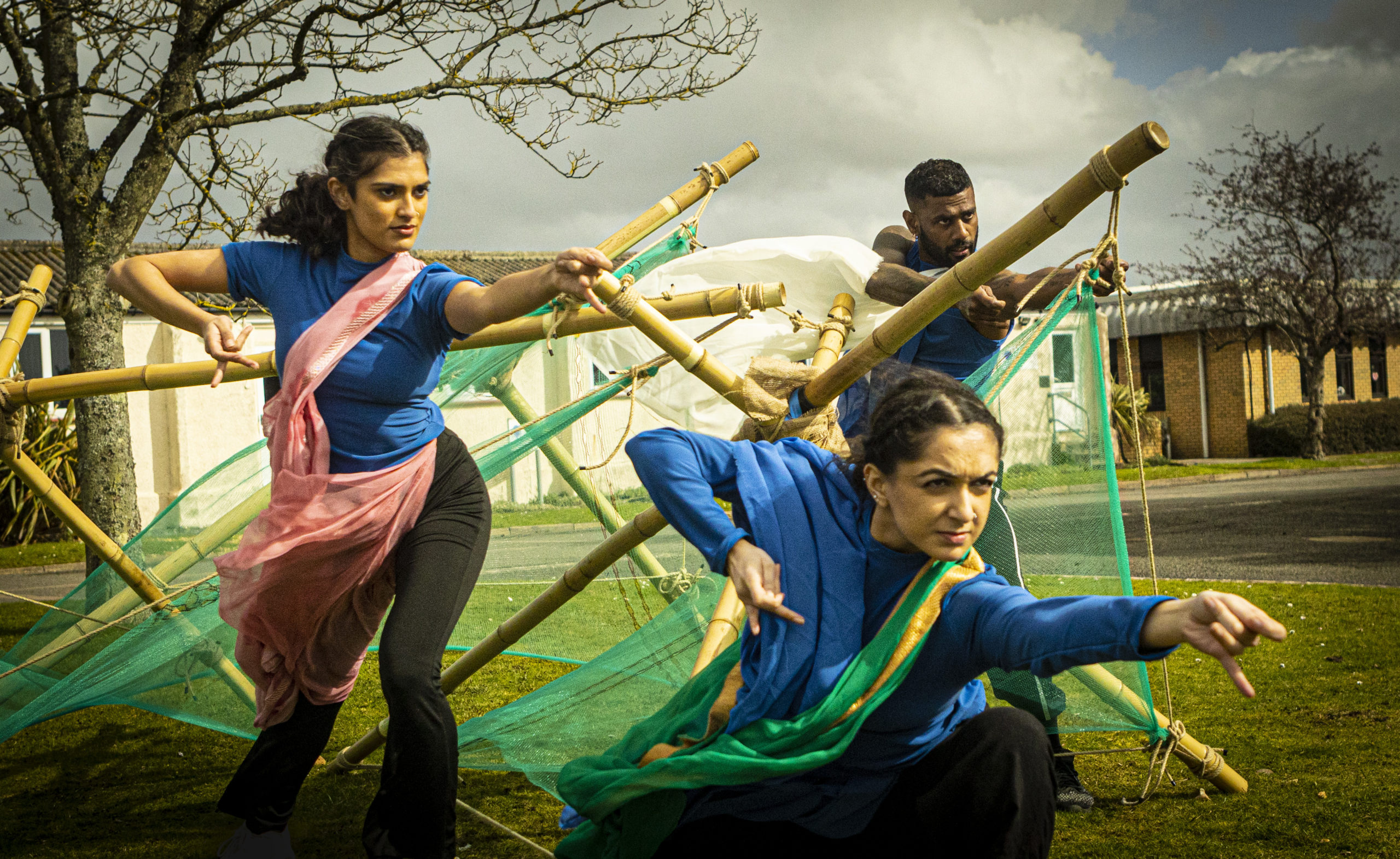Words by Sarah Lapinsky.
Fresh from a day of performances at the Tate Modern, choreographer, Vidya Patel, joined me via Zoom to discuss her work in Akademi’s new piece Pravaas, a site-specific, promenade performance using South Asian dance forms and elements like Carnatic vocals and bamboo structures to tell the stories of the climate-forced migration of the Sundarban people across India and Bangladesh.
I wanted to start our conversation at the beginning, to learn about the moment of inspiration that sparks the idea for Pravaas. Vidya explained how the work was conceived and organised by Suba Subramaniam, the artistic director of Akademi, a leading South Asian dance organisation in the UK founded in 1979.
Fusing science and dance, Suba conducted research for this piece in Sagar, West Bengal, India where extreme weather like cyclones and floods demonstrate the devastating effects of climate change and the urgency to take action to combat the climate crisis. This topic is what initially drew Vidya to the respond to Akademi’s call out for the project. Vidya has also been creating work about the climate and nature for the past five years or so.
Suba seems to have a talent for bringing a team together gathering inter-disciplinary collaborators into the project to bring elements like live Carnatic Vocals performed by Swati Seshadri, symbolic bamboo structures designed by Martin Lines, music from Matt Olden and Kathy Hinde, performances by Mithun Gill, Aishani Ghosh, and Shree Savani and contributions from even more brilliant artists. Vidya explains she often works collaboratively with her performers but that working with such a large team of artists in this way “felt like almost a collective community that’s helping this [work] come to life.” A beautiful sentiment that carries over into the performance of the work focused on humanising the effects of the climate crisis and building connections with their audience.
Entering into R&D, the various elements came together through dialogue and conversations about the experience and stories of migration in the Sundarbans. The performers needed to create authentic connections with the subject matter while understanding that they are not individually affected in the same way. According to Vidya it was about “knowing that [them] telling these stories is very strong because [they] have those connections to the heritage.”
“The team worked to make their process as sustainable and self-sufficient as possible by finding ways to carpool to rehearsals and even recycle found materials like an old fishing net into a prop”
Using classical Indian dance forms to tell the stories of movement of people in South Asia mirrors beautifully and further strengthens the message of the work. Vidya explains the special connection that comes from channeling the forms of Kathak and Bharatanatyam in the work. Both with a rich history of storytelling, using gestures from Bharatanatyam that carry so much meaning “can add to the element of communication in a way that [she] thinks is really, really important,” as Vidya highlights. With further influences from her training and time working with choreographers like Gary Clarke and Sir Richard Alston, the material fuses these traditional aspects of storytelling with a contemporary flair. Working in these specific styles and vocabulary creates a connection between the subject, the audience and the performers which was important to Vidya.
“Because it can be so easy to be like yes, that happens over there. But actually, this is something that is happening because of all of our contributions, the human sort of impact on the climate as well.”
The performers were also challenged to work with the bamboo structures that are moved with them throughout the work. Vidya says, “learning to navigate them within this space has been almost like learning a new movement vocabulary” as the structures are weight bearing but can be manipulated in “very pedestrian type movements that are easily acknowledge by the audience.” Giving herself the challenge to incorporate the structures as part of the dance rather than a separate entity, they treat the props as fellow members of the cast.
“They specifically chose to create a promenade, traveling performance to invite the audience to experience the migration the piece is about”
The bamboo material itself symbolises human resilience and strength, while the structures can represent a “dwelling, boats, [a] home” but in transporting the structures from location to location, they also represent “the constant movement that takes place, specifically in places [where] Suba had done the research” – where scientists are working to find solutions that can combat climate change. Speaking of solutions, I was excited when Vidya mentioned how the team worked to make their process as sustainable and self-sufficient as possible by finding ways to carpool to rehearsals, supply their own equipment, work with the environment and even recycle found materials like an old fishing net into a prop.

Commissioned by Norfolk & Norwich Festival, Brighton Festival and supported by Without Walls, the team knew going in that the piece would be performed outside, but they specifically chose to create a promenade, traveling performance to invite the audience to experience the migration the piece is about.
Moving from site to site, Vidya wanted to highlight that the “one thing that stays together is the communities and actually that it’s the communities that is the home for for the locals rather than being quite focused on this is the place.” So the audience will join the performers in their travels and even be invited into the work to help carry the structures and feel their contributions to the fight to sustain our environment.
Other advantages to performing outside is the accessibility to audience members as the free performance can be followed from the start or joined in the middle. By entering into these new sites, the artists have the opportunity to reframe peoples’ connection to an environment they know and challenge them to see it differently. Of course, there are also challenges as the ground will not be even, they have had to make strategies for sound and contingency plans in case it rains which are keep going unless it’s torrential. As the piece will be performed in different places, there’s a beautiful adaptability about the piece that speaks to the theme. They will be migrating from place to place, assessing and changing the work to fit in a new place in a new way.
Heading into the final three weeks of the process, Vidya was ready to tackle any remaining questions and excited to share the work with audiences! In a work speaking about community and creating connection, Vidya says one of the best aspects of the process has been being able “to openly collaborate with someone who has years and wealth of experience in the realm of science and dance and being able to have open discussions where there is not that sense of like hierarchy as well.” She wonders how we can “cultivate more experiences where choreographers can collaborate together, where we can have spaces which are quite open in the process as well because one thing that is really key to [her] processes is the element of care. And that is one thing that I found with Akademi.” Care and connection. From process to product, the thoughtful, creative collaborations that have built this work will undoubtedly infuse the performances with a sense of community, inviting audiences to experience the effects of climate change in a new way.
Pravaas will be performed at Norwich and Norfolk Festival on 12 May and then tours. For more information about Pravaas and to book visit: https://akademi.co.uk/project/pravaas
